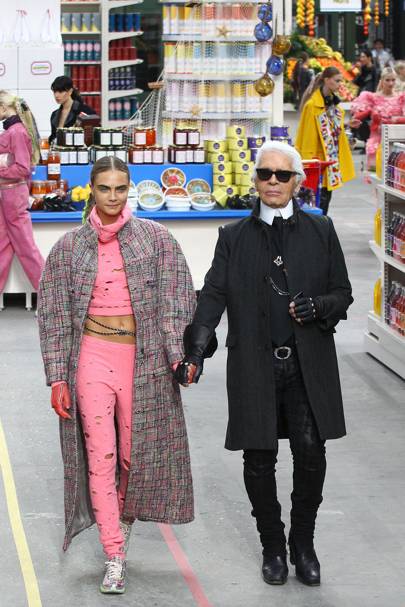Some years later, I started working at W magazine. The editor, Stefano Tonchi, was very close to Karl, and together Stefano and I would go to the Chanel studio, where Karl would talk us through his collections before he presented them on the runway at the Grand Palais. It was during these previews that you really witnessed the magic; where you saw him at his best. Usually at appointments such as this the models aren’t made up, but at Chanel, Karl would have his hair and make-up teams – led by Sam McKnight and Tom Pecheux – create the looks entirely, just so that the few editors he had invited could appreciate them head-to-toe.
It was mesmerising to watch Karl work. His eye for detail was second to none; he would see everything. He was razor-sharp when it came to proportion, shape, texture, colour, detail – if a button on a cuff wasn’t right, then he would see it, when no one else would. (I mean, this was a man who designed the buttons. What creative director designs the buttons these days?) After I’d finally found the courage to talk to him – up until that point, I used to busy myself talking to the models and to Amanda [Harlech, Karl’s right-hand woman] – the conversations didn’t stop. Most of them were too wicked to print; he famously had no filter. His wit and intelligence were unparalleled. We would always begin with fashion gossip, but our chats extended to the books that he was reading, too – his library at home filled his walls floor-to-ceiling. He would talk about art, politics and history.
Karl had an encyclopaedic mind; I would nod along, but would often have to go and research who the hell he was talking about – and it didn’t help that he used to talk so quickly, it was almost impossible to keep up with him. Every time I left him, I felt as though I had been educated. He was so well-versed and cultured; he surrounded himself with great people and great minds. You can’t last as long as he did in this industry if you’re one-dimensional. It’s incredible to think he was at Chanel for 36 years.
Karl had an encyclopaedic mind; I would nod along, but would often have to go and research who the hell he was talking about – and it didn’t help that he used to talk so quickly, it was almost impossible to keep up with him. Every time I left him, I felt as though I had been educated. He was so well-versed and cultured; he surrounded himself with great people and great minds. You can’t last as long as he did in this industry if you’re one-dimensional. It’s incredible to think he was at Chanel for 36 years.

Why was he so successful? Perhaps because he never strayed from the woman: that chic, Chanel woman. He always kept the house elevated. He cleverly kept it aspirational. Every year when I ask my little nieces what they want for Christmas, their reply is always, “A Chanel bag!” That’s because of Karl. You wanted what he was doing, because you wanted to be that woman. His woman. He was committed to beauty and craft like no one else I have ever known.
Another thing I always loved about Karl was that he never rested on his laurels. He had no interest in dwelling on the past – he taught me to live in the present and to look ahead, and he always wanted to find out what was new, what was next. Think of all those models that he cast in his shows and campaigns: Claudia Schiffer, Stella Tennant, Shalom Harlow, Karen Elson and Amber Valletta, through to Cara Delevingne, Edie Campbell, Adwoa Aboah and Adut Akech. He had that knack of picking the right women at the right time, and he pioneered diversity way before many other designers – he regularly cast Naomi Campbell, and he gave Joan Smalls one of her first campaigns.
For all the luxury that surrounded him – and yes, there was plenty of it – Karl was bizarrely grounded. He knew about the times we lived in; he wasn’t disconnected from any of it. Look at those incredible sets he created for his runway shows – one minute you were at an “airport”, the next you were in a “supermarket”. I loved that about him, that he took Chanel – the pinnacle of high fashion – and he put it in a faux supermarket for accessibility. He loved that juxtaposition; he was excellent at mixing high and low cultures.
For all the luxury that surrounded him – and yes, there was plenty of it – Karl was bizarrely grounded. He knew about the times we lived in; he wasn’t disconnected from any of it. Look at those incredible sets he created for his runway shows – one minute you were at an “airport”, the next you were in a “supermarket”. I loved that about him, that he took Chanel – the pinnacle of high fashion – and he put it in a faux supermarket for accessibility. He loved that juxtaposition; he was excellent at mixing high and low cultures.
Over the years, Karl offered me, both professionally and personally, so many words of wisdom. I went to see him when I got the editorship here at Vogue, and he told me: “Just do what you always do, that’s why you’re here, that’s why you got this job.” How simple was that? Karl was always there. But sadly, you often don’t realise how huge a person was in your life until they’re no longer around. There will never be another like him. We have lost one of the greats.

No comments:
Post a Comment